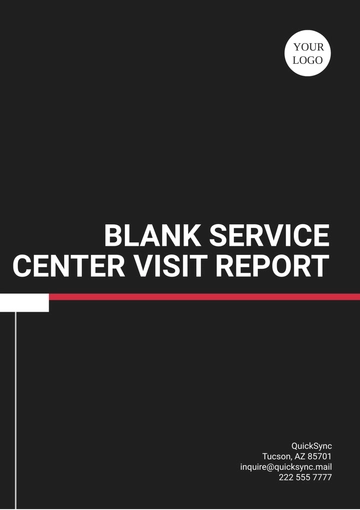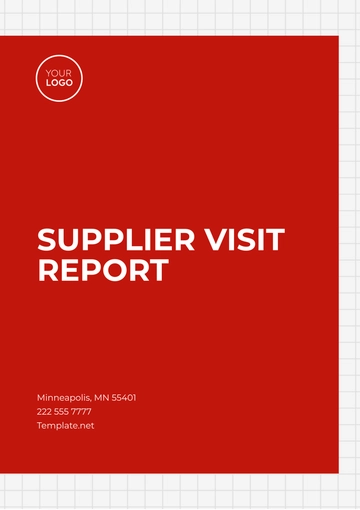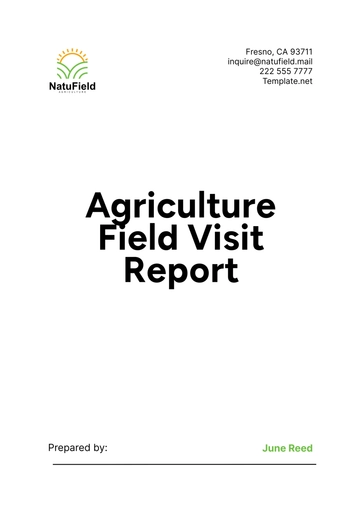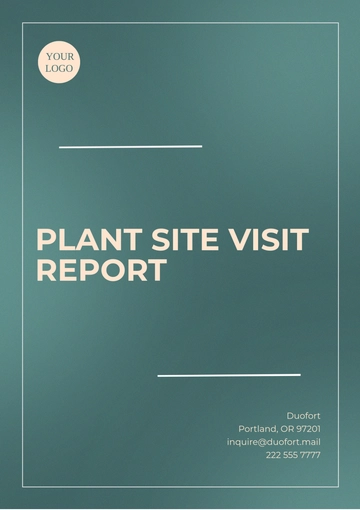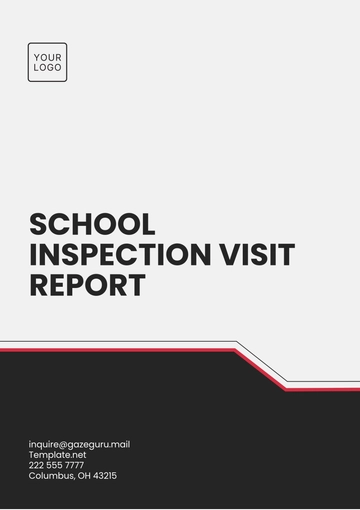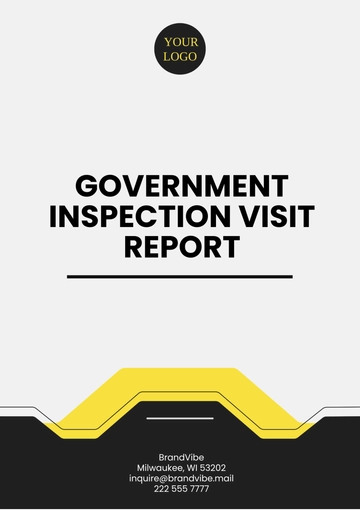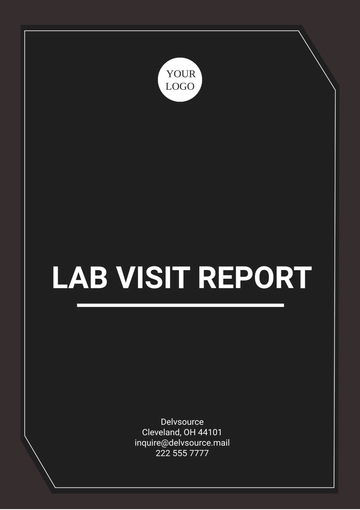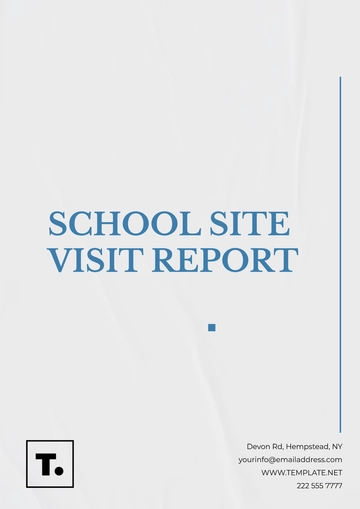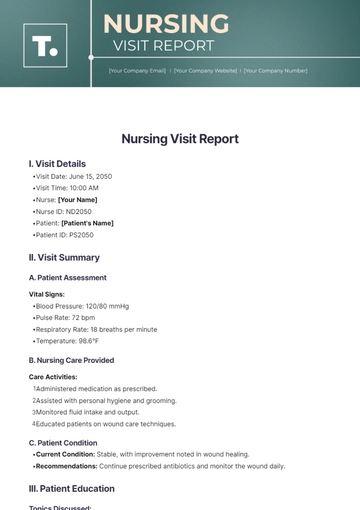Free Agriculture Veterinary Visit Report
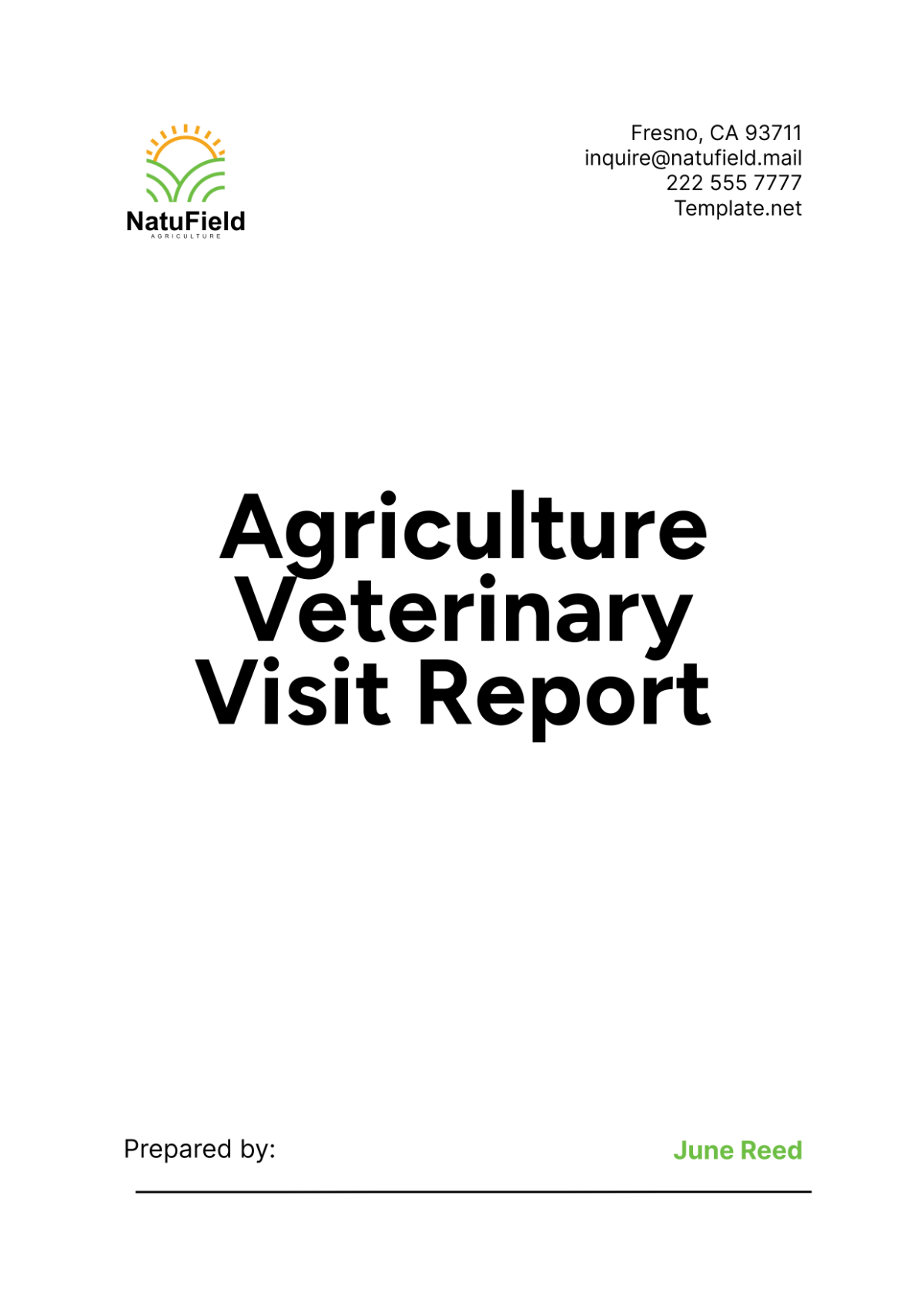
Date of Report: [Date]
Introduction
Purpose
The purpose of this Veterinary Visit Report is to document the findings, treatments, and recommendations from the recent veterinary visit to [Your Company Name]'s agricultural operations. This report aims to provide a comprehensive overview of the health status of our livestock, identify any issues, and outline steps to improve and maintain animal health and productivity.
Scope
This report covers the veterinary examination of all livestock, including cattle, poultry, swine, and sheep, on [Date of Visit]. The visit included routine health checks, vaccinations, treatments for any identified issues, and recommendations for future care.
Summary of Veterinary Visit
The following table provides a detailed summary of the veterinary visit to [Your Company Name], including the date, duration, veterinary team, and the number of livestock examined.
Date of Visit: | July 15, 2050 |
Duration: | 9:00 AM - 3:00 PM |
Veterinary Team: | |
Lead Veterinarian | [Veterinarian's Name] |
Assistants/Technicians | [Name/s] |
Livestock Examined: | |
Cattle | 120 |
Poultry | 500 |
Swine | 80 |
Sheep | 150 |
Examination Findings
Cattle
General Health
Metric | Findings |
|---|---|
Body Condition Score (BCS) | Average BCS of 5 on a scale of 1-9 |
Respiratory Health | No signs of respiratory distress or illness |
Digestive Health | Normal rumination and fecal consistency |
Skin and Coat Condition | Healthy skin and coat, no signs of parasites |
Specific Issues
Lameness: Identified in 3 cows, likely due to foot rot. Treatment administered.
Mastitis: Detected in 2 cows. Treated with antibiotics, and milking practices reviewed for hygiene.
Poultry
General Health
Metric | Findings |
|---|---|
Feather Condition | Healthy feathers, no signs of feather loss |
Respiratory Health | No signs of respiratory distress or illness |
Digestive Health | Normal fecal consistency, good feed intake |
Egg Production (if applicable) | Normal production levels for the breed |
Specific Issues
Coccidiosis: Identified in a small percentage of the flock. Treated with coccidiostats, and sanitation practices reviewed.
Pecking Injuries: Minor injuries observed in 5 birds, treated with antiseptics and monitored.
Swine
General Health
Metric | Findings |
|---|---|
Body Condition Score (BCS) | Average BCS of 6 on a scale of 1-9 |
Respiratory Health | No signs of respiratory distress or illness |
Digestive Health | Normal fecal consistency and feed intake |
Skin and Coat Condition | Healthy skin and coat, no signs of parasites |
Specific Issues
Respiratory Issues: Mild respiratory symptoms in 4 pigs, treated with antibiotics.
Skin Lesions: Minor lesions due to mange observed in 3 pigs, treated with antiparasitics.
Sheep
General Health
Metric | Findings |
|---|---|
Body Condition Score (BCS) | Average BCS of 5 on a scale of 1-9 |
Respiratory Health | No signs of respiratory distress or illness |
Digestive Health | Normal rumination and fecal consistency |
Wool Condition | Healthy wool, no signs of parasites or wool loss |
Specific Issues
Foot Rot: Identified in 4 sheep, treated with foot baths and antibiotics.
Internal Parasites: Evidence of parasitic infestation in fecal samples, treated with anthelmintics.
Treatments Administered
Cattle
Lameness: Foot baths with zinc sulfate and systemic antibiotics administered.
Mastitis: Intramammary antibiotics and anti-inflammatory medications given. Hygienic milking procedures reinforced.
Poultry
Coccidiosis: Medicated feed with coccidiostats administered. Increased sanitation measures implemented.
Pecking Injuries: Antiseptics applied, and environmental enrichment provided to reduce pecking.
Swine
Respiratory Issues: Broad-spectrum antibiotics administered.
Skin Lesions: Antiparasitic treatments given, and housing conditions reviewed for improvements.
Sheep
Foot Rot: Foot baths with copper sulfate and systemic antibiotics administered.
Internal Parasites: Anthelmintic treatment given, and pasture management reviewed to reduce parasite load.
Recommendations
General Recommendations
1. Regular Health Monitoring
Implementing routine health checks is crucial for maintaining the overall health and productivity of livestock. Regular health monitoring allows for the early identification of potential issues, such as disease outbreaks, nutritional deficiencies, or injuries. Early detection is key to preventing minor problems from escalating into major health crises that can affect the entire herd or flock.
Frequency: Conduct health checks weekly for poultry and swine, and monthly for cattle and sheep.
Procedures: Include visual inspections, physical examinations, and the use of diagnostic tools as needed.
Documentation: Maintain detailed records of each health check to track trends and identify recurring issues.
2. Hygiene Practices
Maintaining and improving hygiene practices across all animal housing and milking areas is essential for preventing the spread of diseases and ensuring the well-being of the livestock. Proper hygiene reduces the risk of bacterial, viral, and parasitic infections.
Cleaning Protocols: Establish daily cleaning routines for all housing areas, with deep cleaning sessions scheduled weekly.
Milking Hygiene: Implement strict milking hygiene practices, including regular sanitization of milking equipment and proper handwashing techniques for workers.
Waste Management: Ensure efficient waste removal systems are in place to prevent the buildup of manure and other waste products.
3. Nutrition
Balanced and adequate nutrition is fundamental to supporting the overall health and productivity of livestock. Providing a diet that meets the nutritional needs of each species is vital for their growth, reproduction, and disease resistance.
Feed Quality: Source high-quality feed and regularly test for nutritional content to ensure it meets the animals' requirements.
Supplementation: Provide necessary supplements, such as vitamins and minerals, to address any deficiencies.
Feeding Schedule: Establish consistent feeding schedules to maintain regular nutrient intake and promote digestive health.
Specific Recommendations
Cattle
1. Foot Health
Implementing a regular hoof trimming schedule is essential for preventing lameness, which can significantly impact cattle's mobility and overall health. Lameness is often caused by overgrown hooves, infections, or injuries.
Trimming Schedule: Trim hooves every six months or as needed based on individual assessments.
Training: Ensure staff are trained in proper hoof trimming techniques or hire professional hoof trimmers.
Environmental Management: Maintain dry and clean flooring in barns and pastures to reduce hoof-related issues.
2. Mastitis Prevention
Mastitis is a common and costly disease in dairy cattle, affecting milk production and quality. Improving milking hygiene practices can significantly reduce the incidence of mastitis.
Pre-Milking: Clean and sanitize udders before each milking session.
Post-Milking: Apply teat disinfectants after milking to prevent bacterial entry.
Equipment Maintenance: Regularly clean and service milking equipment to ensure it is functioning correctly and hygienically.
Poultry
1. Sanitation
Increasing the cleaning frequency of poultry housing is vital for preventing coccidiosis, a parasitic disease that can cause significant morbidity and mortality in poultry flocks.
Daily Cleaning: Remove manure and replace bedding material daily.
Disinfection: Use appropriate disinfectants to clean housing structures weekly.
Water Management: Ensure waterers are clean and free from contamination to prevent disease spread.
2. Environmental Enrichment
Providing environmental enrichment is essential for reducing pecking injuries, which can occur due to boredom or stress in poultry.
Perches: Install additional perches to encourage natural roosting behavior.
Foraging Opportunities: Scatter feed or provide forage materials to stimulate foraging behavior.
Space: Ensure adequate space per bird to reduce stress and aggressive behaviors.
Swine
1. Respiratory Health
Ensuring proper ventilation in swine housing is crucial for reducing respiratory issues, which are common in confined animal feeding operations.
Ventilation Systems: Install and maintain effective ventilation systems to control humidity and temperature.
Air Quality Monitoring: Regularly monitor air quality for ammonia and dust levels, adjusting ventilation as needed.
Quarantine Protocols: Isolate new or sick animals to prevent the spread of respiratory infections.
2. Skin Health
Regularly inspecting swine for signs of mange and other skin conditions is important for maintaining skin health and preventing infestations.
Inspection Schedule: Conduct skin inspections weekly.
Treatment: Treat any signs of mange promptly with appropriate antiparasitic medications.
Hygiene: Maintain clean bedding and housing to reduce the risk of skin infections.
Sheep
1. Foot Rot Prevention
Implementing regular foot baths and monitoring for signs of foot rot are essential for preventing this debilitating condition in sheep.
Foot Baths: Use foot baths with copper sulfate or zinc sulfate solutions weekly.
Pasture Management: Rotate pastures to prevent the buildup of bacteria that cause foot rot.
Foot Inspections: Conduct regular foot inspections and promptly treat any signs of infection.
2. Parasite Management
Rotating pastures and implementing strategic deworming are crucial for controlling internal parasites in sheep, which can significantly impact their health and productivity.
Pasture Rotation: Rotate pastures to break the lifecycle of parasites and reduce contamination.
Deworming Schedule: Implement a deworming schedule based on fecal egg counts and veterinary recommendations.
Fecal Monitoring: Regularly monitor fecal samples for parasite loads and adjust deworming protocols as needed.
Follow-Up
Next Visit
The next veterinary visit is scheduled for [Date of Next Visit]. This visit will include follow-up checks on the treated issues and a general health assessment of all livestock.
Action Items
Lessor: Ensure all recommended treatments and preventive measures are implemented.
Lessee: Maintain records of treatments and monitor livestock for any signs of recurring issues.
Conclusion
The veterinary visit on [Date] provided a comprehensive assessment of the health status of the livestock at [Your Company Name]. The treatments administered and the recommendations provided aim to enhance the overall health and productivity of the animals. Implementing these measures will contribute to the sustainability and success of our agricultural operations.
For any questions or further information regarding this report, please contact [Veterinarian's Name] at [Veterinarian's Contact Information].
Appendices
Appendix A: Detailed Health Metrics
Species | Health Metric | Value |
|---|---|---|
Cattle | Average Body Condition Score (BCS) | 5 on a scale of 1-9 |
Poultry | Egg Production (if applicable) | Normal for breed |
Swine | Average Body Condition Score (BCS) | 6 on a scale of 1-9 |
Sheep | Average Body Condition Score (BCS) | 5 on a scale of 1-9 |
Appendix B: Treatment Records
Species | Treatment Administered | Dosage | Administered By |
|---|---|---|---|
Cattle | Intramammary antibiotics | As per veterinarian's instructions | [Veterinarian's Name] |
Poultry | Coccidiostats | Medicated feed | [Veterinarian's Name] |
Swine | Broad-spectrum antibiotics | As per veterinarian's instructions | [Veterinarian's Name] |
Sheep | Anthelmintics | As per veterinarian's instructions | [Veterinarian's Name] |
Appendix C: Photographic Evidence
Photos taken during the veterinary visit to document conditions and treatments administered.
By adhering to the recommendations and follow-up actions outlined in this report, [Your Company Name] can ensure the continued health and productivity of its livestock, contributing to the overall success of its agricultural operations.
- 100% Customizable, free editor
- Access 1 Million+ Templates, photo’s & graphics
- Download or share as a template
- Click and replace photos, graphics, text, backgrounds
- Resize, crop, AI write & more
- Access advanced editor
Ensure thorough health management of your livestock with Template.net's Agriculture Veterinary Visit Report Template. This template facilitates detailed documentation of veterinary visits, including observations, treatments, and recommendations. Fully editable and customizable with our AI editor tool, it helps you maintain accurate health records, enhancing the overall care and management of your farm animals.
You may also like
- Sales Report
- Daily Report
- Project Report
- Business Report
- Weekly Report
- Incident Report
- Annual Report
- Report Layout
- Report Design
- Progress Report
- Marketing Report
- Company Report
- Monthly Report
- Audit Report
- Status Report
- School Report
- Reports Hr
- Management Report
- Project Status Report
- Handover Report
- Health And Safety Report
- Restaurant Report
- Construction Report
- Research Report
- Evaluation Report
- Investigation Report
- Employee Report
- Advertising Report
- Weekly Status Report
- Project Management Report
- Finance Report
- Service Report
- Technical Report
- Meeting Report
- Quarterly Report
- Inspection Report
- Medical Report
- Test Report
- Summary Report
- Inventory Report
- Valuation Report
- Operations Report
- Payroll Report
- Training Report
- Job Report
- Case Report
- Performance Report
- Board Report
- Internal Audit Report
- Student Report
- Monthly Management Report
- Small Business Report
- Accident Report
- Call Center Report
- Activity Report
- IT and Software Report
- Internship Report
- Visit Report
- Product Report
- Book Report
- Property Report
- Recruitment Report
- University Report
- Event Report
- SEO Report
- Conference Report
- Narrative Report
- Nursing Home Report
- Preschool Report
- Call Report
- Customer Report
- Employee Incident Report
- Accomplishment Report
- Social Media Report
- Work From Home Report
- Security Report
- Damage Report
- Quality Report
- Internal Report
- Nurse Report
- Real Estate Report
- Hotel Report
- Equipment Report
- Credit Report
- Field Report
- Non Profit Report
- Maintenance Report
- News Report
- Survey Report
- Executive Report
- Law Firm Report
- Advertising Agency Report
- Interior Design Report
- Travel Agency Report
- Stock Report
- Salon Report
- Bug Report
- Workplace Report
- Action Report
- Investor Report
- Cleaning Services Report
- Consulting Report
- Freelancer Report
- Site Visit Report
- Trip Report
- Classroom Observation Report
- Vehicle Report
- Final Report
- Software Report


